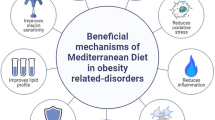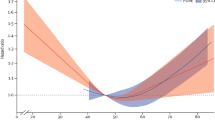Summary
Background
To investigate dietary habits and evaluate these with regard to cardiovascular risk status in Turkish adolescents aged 12–19 years.
Methods
A total of 300 adolescents, 135 males and 165 females aged between 12 and 19, were included in the study. Dietary intake was determined by using 3–day food records (including 1 weekend day). Adolescents’ smoking habits and familial chronic diseases were recorded. The values obtained for energy and nutrient intakes were compared with RDA and DRI and recommendations given by AHA.
Results
The mean energy intakes of male and female subjects were 1964 ± 723 kcal and 1804 ± 486 kcal respectively. According to NHANES III, age–standardized (CDC: Centers for Disease Control and Prevention) prevalence of overweight indicated that 20.7% among male and 17.5% among female adolescents were at risk for becoming overweight. The prevalence of premature CHD family history was found to be 9.6% for males and 11.5 % for females. The prevalence of current smoking was found to be 22.2 % for males and 18.2 % for females. In addition, 29.6% of the males and 37.6% of the females were physically inactive (p < 0.05); however, male adolescents (48.2%) were significantly more likely than female adolescents (52.1 %) to report sufficient moderate physical activity (p < 0.05). The dietary fiber intake was slightly below the recommended intake of 10 g per 1000 kcal. Compared to the AHA averages, these adolescents had significantly higher intake of total fat, saturated fat, sodium and dietary cholesterol and lower intake of polyunsaturated fat, monounsaturated fat and dietary fiber. The Turkish adolescents also had higher amounts of energy from fat. The mean percentage of energy from fat was 34.2 ± 6% TE for males and 35.2 ± 6.8 % TE for females; saturated fat was 11.8 ± 6.8 % TE for males and 12.1 ± 8.9 for females. The intake of fat and saturated fat was higher than the AHA recommendations. The polyunsaturated to saturated fat ratio was 0.4 ± 0.2 and reflected a high saturated fat (12.0 ± 7.7% TE) and low polyunsaturated fat (5.5 ± 3.9 % TE) diet. In addition, the percentage of adolescents who did not meet 66% of RDA for vitamin E, B6, and folates and the recommendation for RDA dietary fiber is presented. Approximately, 80% of adolescents failed to meet the dietary recommendation of the AHA for polyunsaturated fatty acids, and about 26.7% reported a cholesterol intake higher than 100 mg/1000 kcal.
Conclusion
It can be said that fiber, total fat, saturated fatty acid, cholesterol and sodium intake of Turkish adolescents are found to be high; however, their vitamin E, vitamin B6 and folate intake are found to be low compared to AHA recommendations. Turkish adolescents’ fruit and vegetable intake are also found to be low.
Similar content being viewed by others
Author information
Authors and Affiliations
Corresponding author
Rights and permissions
About this article
Cite this article
Baş, M., Altan, T., Dinçer, D. et al. Determination of dietary habits as a risk factor of cardiovascular heart disease in Turkish adolescents. Eur J Nutr 44, 174–182 (2005). https://doi.org/10.1007/s00394-004-0509-8
Received:
Accepted:
Published:
Issue Date:
DOI: https://doi.org/10.1007/s00394-004-0509-8




